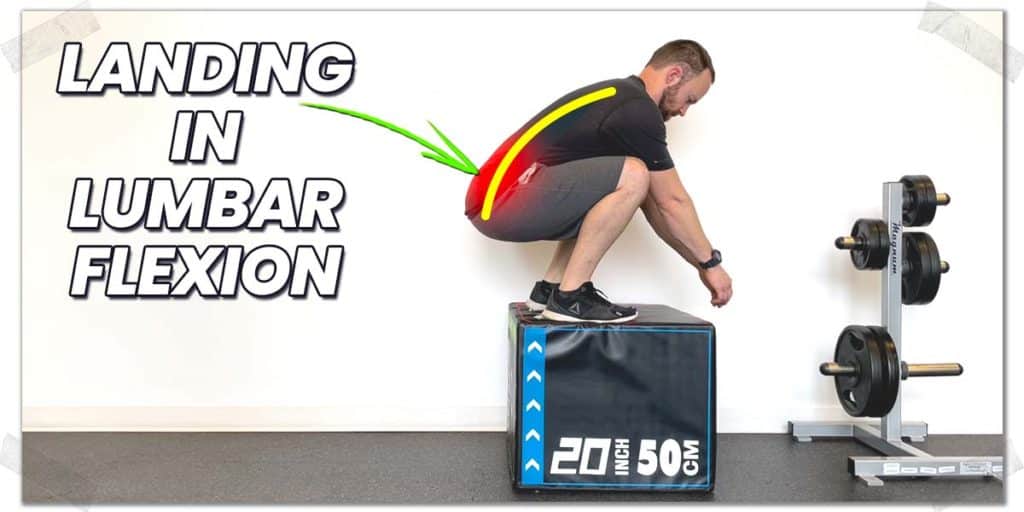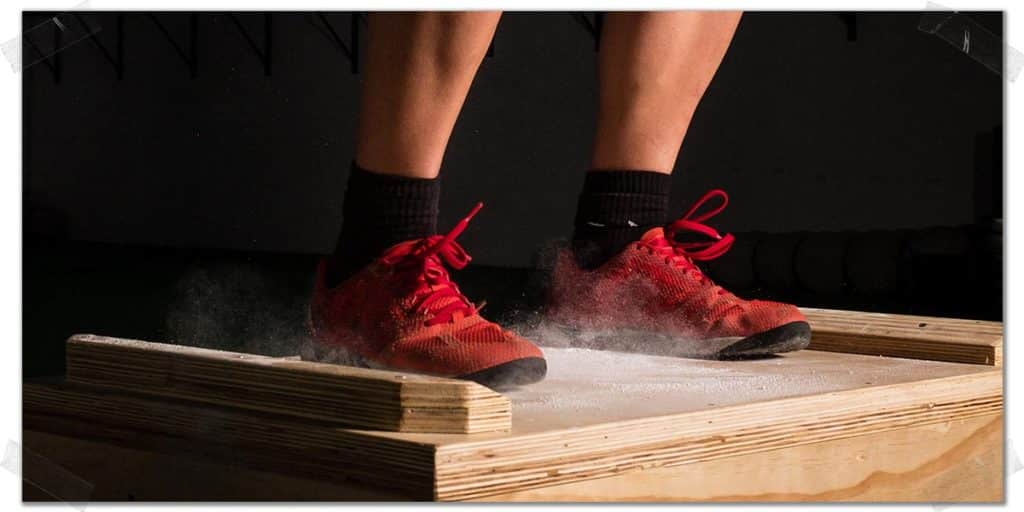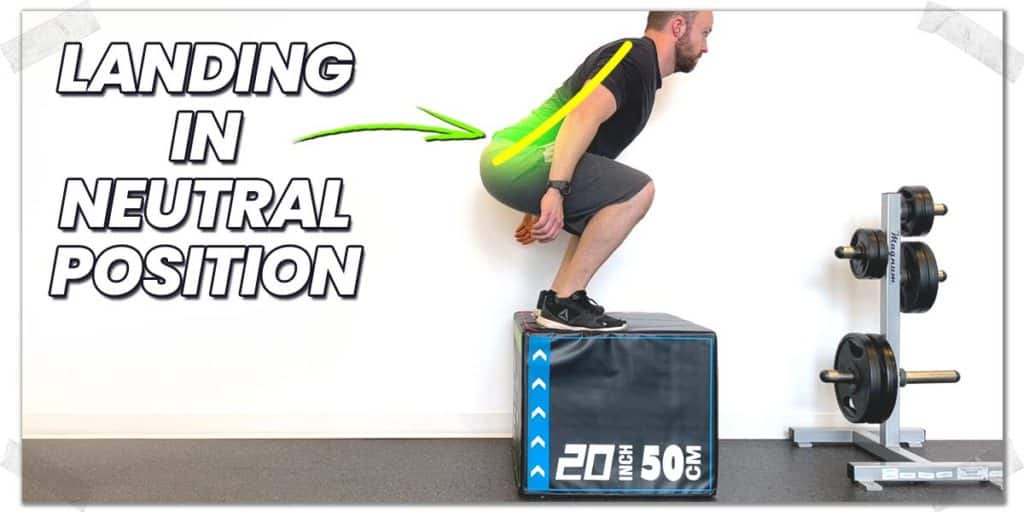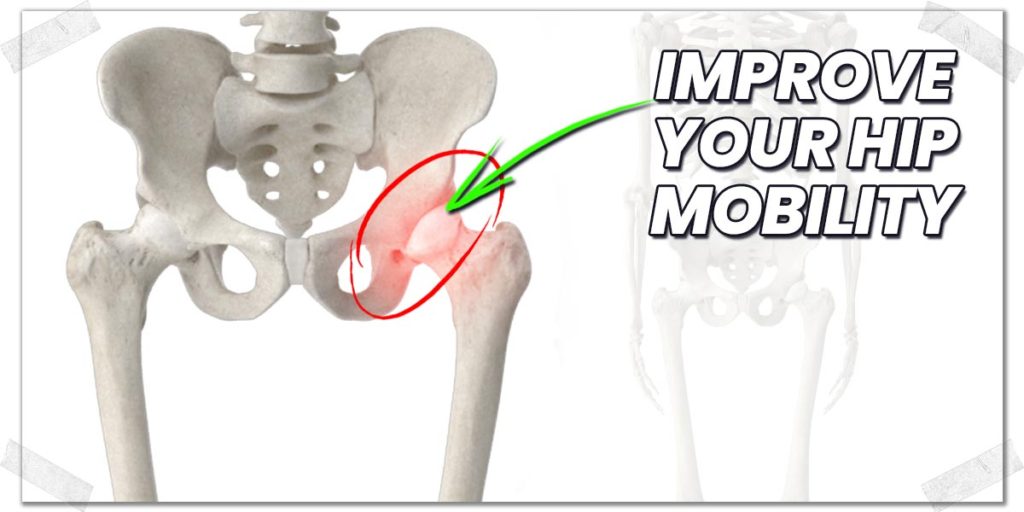The box jump can be a highly beneficial exercise when it comes to developing explosive power, endurance, and even lower body flexibility. But if it’s wreaking havoc on your lower back, the only thing it’s likely to develop for you is pain and misery. So, if your lower back is acting up during (or after) doing some box jumps, you’ll want to read all the insight, tips and solutions packed within this article.
Lower back pain from box jumps is often the result of landing with excessive lumbar flexion of the spine, landing with excessive force, poor movement mechanics, and poor hip mobility. Solutions involve optimizing box height for your jumps, improving landing technique, and improving hip mobility.
To be clear, there can be various other reasons why your lower back is feeling tweaked from your box jumps. Still, I find the vast majority of otherwise healthy individuals who suffer from back pain after their box jumps are making at least one of these common errors described above. Thankfully, these issues are often pretty straightforward to clean up and avoid with future jumps.
If you want the full breakdown on how to protect your lower back health with your box jumps, keep on reading!

ARTICLE OVERVIEW (Quick Links)
Click/tap on any headline below to instantly read that section!
Mistake 1: Landing in lumbar flexion
Mistake 2: Landing with excessive force
Mistake 3: Inappropriate box height
Fix 1: Using optimal box height
Fix 2: Stacking the lower body
Fix 3: Improving hip mobility
Related article: Six Benefits of Using an Acupressure Mat for Your Aches and Pains
Mistake 1: Repeatedly landing in lumbar flexion

Let’s start off with the most common mistake of them all: landing with excessive lumbar flexion (rounding) of the lumbar spine.
There are numerous reasons as to why this happens (all of which will be discussed in the article), but the result is the same: compromising the integrity of the discs and joints of the lower back, which can range from acute mild irritation to moderate, chronic pain.
Now, just so we’re clear: in an otherwise healthy spine, flexion of the lumbar spine by itself isn’t necessarily some sort of position that will immediately blow out your back and cripple you. However, repeated high-intensity and high-speed movements subjecting a flexed lumbar spine to high levels of force can absolutely be irritating or detrimental to the involved tissues.
Assuming that you’ve been doing more than a couple of box jumps and consistently landing with a flexed lumbar spine, the repeated strain on the discs, joints, and other tissues might be rearing its ugly head in the form of discomfort or pain.
Excessive pressure or downward force on the spine when in a flexed position can be incredibly stressful on the annular fibers of the intervertebral discs, which can weaken the integrity of the disc and lead to disc bulges or herniations. The extreme ranges of flexion can also place high levels of stress on the facet joints of the lumbar spine, which can also be quite painful to endure.
Related article: Why Russian Twists are Hurting Your Back (and What to do About it)
Generally speaking, the healthier your spine is, the longer you can get away with making this mistake. Spines that are less mobile, already compromised, afflicted with previous injury, etc., will likely have less capacity to endure this movement error before discomfort or pain becomes noticeable.
I must also point out here that the more you approach the absolute limits of your maximal box jump height, the more you will likely have to land with a certain degree of lumbar flexion. This is why I often advise my patients to only test maximal and near-maximal box jump heights if their back is otherwise healthy and they have adequate landing mechanics with their jumps.
Reasons for landing with a flexed lumbar spine
There are multiple reasons why landing with a rounded lumbar spine is so common with box jumps. Determining the root cause of why this is occurring is your ticket out of this mess, allowing you to jump again with complete confidence and without pain.
The most common reasons for landing with a flexed spine include:
- Not understanding the appropriate landing position
- A lack of positional awareness during your landing
- Jumping on a box that is a bit too high for your movement abilities
Each of these issues (and how to fix them) is fully addressed in detail in the article’s following “fix” sections.
Mistake 2: Landing with excessive force

Another surefire way to irritate your lower back when doing box jumps is to land with excessive force on each and every jump that you perform. This is especially true if you’re landing on a rigid box or surface (padded boxes can absorb a decent amount of your landing force).
Repeatedly hard landings on a hard surface will create repeatedly hard impacts on your joints.
This is the ol’ physics rule of “for every action, there is an equal and opposite reaction,” meaning the harder you stomp down on your landing, the harder the landing forces will “stomp” back into you. Repeated hard forces travelling through your body will result in more force running through your spine, which no doubt can become painful on your lower back as more and more jumps are performed. You want to absorb as much force as possible with each landing so as to soften the forces travelling through your body.
The solution is to use the muscles of your legs as shock absorbers, allowing the force to be dispersed into your leg muscles rather than the joints and muscles of your spine. Ideally, you’ll bend your knees as much as possible without rounding your lower back in the process.
Pro tip: As a general rule, the louder your landing is, the greater the force you’re putting through the joints in your body (such as your lower back). Make an effort to keep your landings as quiet as possible, which will signify maximal force absorption is taking place through your legs rather than your back and spine.
Mistake 3: Inappropriate box height
While it’s a whole lot of fun to jump onto a high box and test your limits, some potential factors can tweak or set off your back if the height is higher than what your body can tolerate.
The maximal height that you can attain when jumping onto a box is the product of two distinct factors:
- How much explosive power your muscles can generate to propel you upwards.
- How mobile your lower body is (particularly your hips); the greater range of motion you can achieve with tucking your knees up to your chest (i.e., hip flexion), the higher the surface your feet can clear.
The less power you can generate for jumping upwards, the greater you must flex (bend) your hips to pull your feet above the landing surface.
And herein lies the problem: the more you flex your hips, the greater you’re likely to flex your lumbar spine (leading us back to mistake number 1). And the higher your box jump, the more likely this is to occur. Again, it’s worth pointing out that this might not be problematic for an otherwise healthy back, but it likely is for one that isn’t healthy to begin with.
The problem gets only worse if you have lousy hip mobility; the less you can flex your hips up towards your chest, the more your body will likely compensate by flexing through your lower back (you’ll want to pay extra close attention to solution 1 and solution 3 to offset this issue).
Fix 1: Using optimal box height
The quickest solution for making an effective change with your box jumps is to decrease the height of the box or surface you’re jumping onto. It might not be a sexy solution and one that bruises the ego a bit, but it will allow you to keep on doing box jumps (provided your back can tolerate doing so) while also giving you a chance to perfect your jump and landing technique in the process.
Lower-height jumps are the way to go when it comes to practicing perfect execution of your landing technique; yes, jumping and landing on a box with perfect technique can take practice. I get that it seems absurd to have to practice technique with such a movement, but the more you clean up your technique on ANY movement or exercise, the better off you’ll be from both a safety perspective and a performance perspective.
So, if you can’t hold perfect landing technique (discussed further in solution 2), regress the box height as much as necessary until you can land on the box without tweaking your back and with perfect form. As time goes on, you’ll likely improve and will be able to increase the box height as a result.
Fix 2: Stacking the lower body

“Stacking” the lower body refers to the ideal positioning of the feet, knees, hips, and lower back to ensure maximal safety and performance of the entire body. Strength and stability of the body are nothing if it has a shaky, misaligned foundation beneath.
The landing position of your box jumps should be one that:
- Has the feet approximately shoulder-width apart (or a bit wider)
- A moderate bend of the knees
- Knees stacked on top of the toes/feet
- The center of the body’s mass directly under the feet
- The hips moderately bent or flexed
- The lower back flattened
- The mid and upper back flattened
Every time you land your box jump in a position without the positions described above, not only are you predisposing various joints of your body (including your lower back) to potential injury, you’re also developing lousy training habits that will rob you of performance.
If you know anything about proper squat technique (and it’s just fine if you don’t), you’ll realize that the points above for stacking your lower body when landing the box jump are essentially the same points you would follow for holding and performing a squat.
A proper stack is fundamental to master, not just for landing box jumps but for numerous other gym-based and sporting-based exercises as well. So, get in the habit of becoming aware of your landing position with each jump.
Pro tip: When ensuring you have perfect landing technique, hold your landing position and don’t move (once you’re done absorbing the landing force). Take a second to feel the position that you landed in and feel if it’s good or could be better. Look down at your feet and knees and determine if they’re where they need to be. How’s your weight distribution and balance? How’s the position of your lower back — is it rounded or flat? Perform this quick check for every rep until you land perfectly at least a dozen times in a row.
Fix 3: Improving hip mobility

If you find that you round your spine every time you land the box jump and absorb the force through bending your knees and hips (to soften the impact), it may be that the underlying cause is due to poor hip mobility.
The hip joint is a ball and socket joint, and as such, bending the hip (flexing it) should cause the ball to turn in the socket, producing the movement. The hip joint can become stiff and hypomobile (not moving enough) for various reasons. When this occurs, the ball cannot turn adequately within the socket.
Regardless of why this happens, the end result is that when dropping into a stacked position or into a squat, movement will have to arise elsewhere in the body to make up for the lack of the hip joint’s mobility. It just so happens that this compensatory movement most often arises in the joints of the lower back.
This compensatory movement is infamously known as “butt wink,” and it can get lifters and athletes into trouble real quick when it comes to the health of their lower back. The problem is that this “butt wink” is not the fault of the lower back but the impaired mobility of the hip joint (either on one side or both).
If you know that you have tight hips or always have “butt wink” whenever performing squatting-based movements, you’ll want to dedicate yourself to improving your hip mobility.
While specific exercises are beyond the scope of this article, ensuring that the hip capsule has adequate mobility is a good place to start. Sometimes the issue is more of the fault of soft-tissue (i.e., muscle) restrictions; however, I most often see the capsule being the limiting factor with the athletes whom I treat for this condition.
Final thoughts
Box jumps are an outstanding exercise for numerous reasons. Back pain sucks for numerous reasons. Retaining the ability to perform box jumps for all your days ahead is a training goal worth striving for. If your lower back is getting tweaked from any aspect of this exercise, get on top of the issue as quickly as possible.
Use the information within this article as a starting point for getting this annoying issue taken care of so that you can get back to hard — but smart — training. You’ve got this!

Hi! I’m Jim Wittstrom, PT, DPT, CSCS, Pn1.
I am a physical therapist who is passionate about all things pertaining to strength & conditioning, human movement, injury prevention and rehabilitation. I created StrengthResurgence.com in order to help others become stronger and healthier. I also love helping aspiring students and therapists fulfill their dreams of becoming successful in school and within their clinical PT practice. Thanks for checking out my site!

